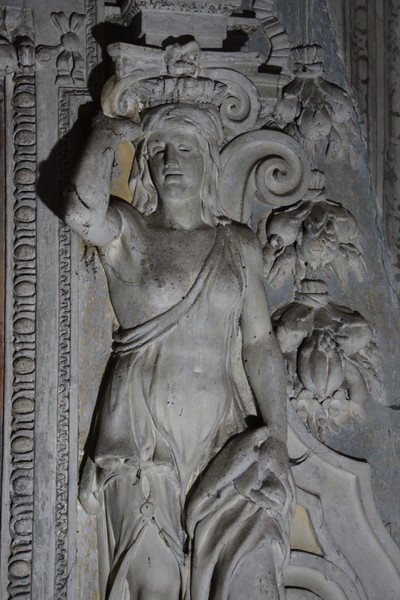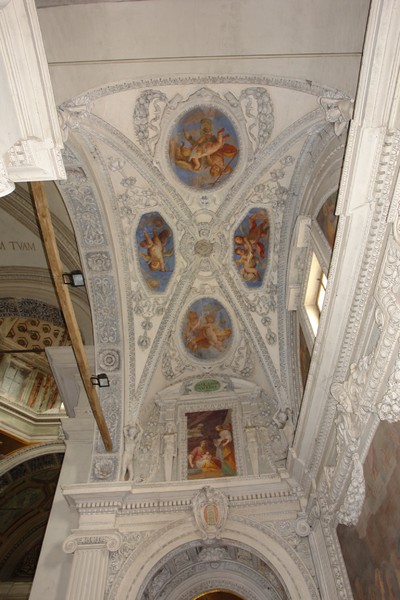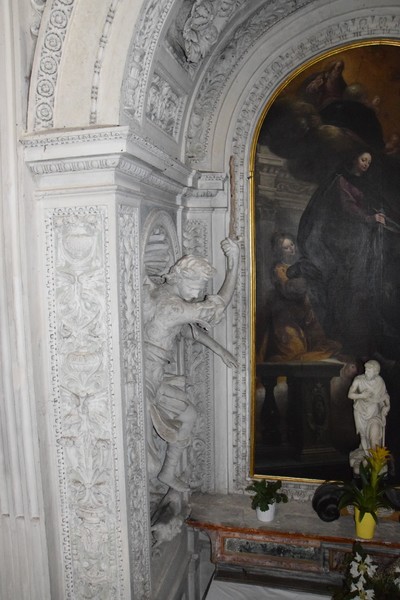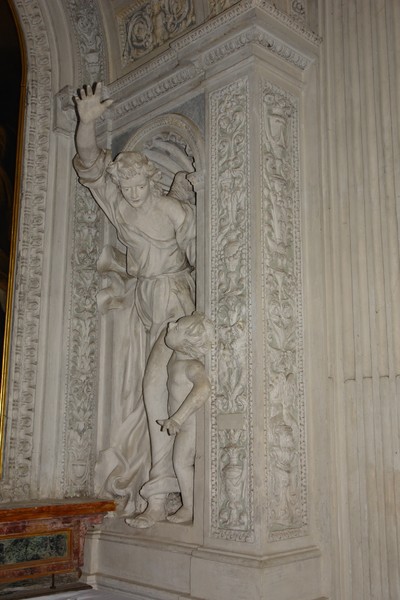PARISH CHURCH OF SAINTS GEORGE AND ANDREW
Chiesa parrocchiale dei Santi Giorgio e Andrea
Via Principale 30
6914 Carona - Lugano
Of Romanesque foundation, the church was radically transformed and enlarged during the 15th century, following the granting of parish autonomy (1427). The works were completed in 1506, as indicated in an epigraph on the entablature of the façade. The triple-nave interior preserves valuable works dating as early as the 1400s. In the last decades of the 1500s, reinforcements were provided for the pillars supporting the bays and for construction of the tiburium. An intense decorative campaign was also begun, including the creation of the balustrade, painting of frescos in the choir, and decorations for the chapels of the Rosary and St John the Baptist (later dedicated to St Dominic Soriano). The Bishop of Como, Feliciano Ninguarda, on the occasion of a pastoral visit of 11 June 1591, wrote that “la chiesa è la più bella che sii nela Plebe de Lugano et altre, fatta con quelle circostanze che l’homo possi imaginare” 1. The decorations were completed over the next century, mostly by masters from Carona2.
The church was restored in 1966-70 under the direction of Guido Borella, and in 1974-79 under the direction of Tita Carloni (Fig. 1).
Chapel of the Rosary
The chapel occupies the entire narrow and tall end wall of the left nave. It belongs to the Community of Carona and since 1579 has been dedicated to the Rosary. The decoration, completed by 1591, was sponsored by the Casella family, whose coat of arms, supported by two cherubs, is at the apex of the entrance arch (Fig. 2, 3). In the acts of the visit of 11 June of 1591, Feliciano Ninguarda, Bishop of Como, mentions “doi [due] altri altari, uno è finito, di belliss.a manuf.ra … et l’altro si va facendo a stucho di tutta bellezza” 3.
The stucco decorations are attributed to Giovanni Battista Casella (documented from 1550 to 1602) 4 and have been compared to those in the chapel of Palazzo Salviati alla Lungara in Rome5. The furnishings were completed between 1636 and 1670, with the creation of the balustrade in Arzo marble and the antependium in inlaid marble, probably from Genoa6.
On either side of the wooden statue of the Virgin, placed in the central niche, are four stucco sculptures in almost full-round. On the left are St Sebastian and St John the Baptist, on the right St Roch and St Lucy; two of these are placed in facing niches surrounded by grotesques in bas-relief. Two Prophets repose on the sides of the extrados (Fig. 4).
The decoration terminates above with God the Father blessing in high relief, supported by angels, and on the cymatium, a sumptuous framing of the wall painting depicting the Coronation of the Virgin, attributed to Andrea Casella (1619-ante 1672) (Fig. 5, 6). At the sides of the cymatium, between pendants and garlands of flowers and fruit, two caryatids support the entablature of the broken pediment (Fig. 7, 8). A memorial plaque at the entrance to the chapel commemorates the death of Giovanni Battista Casella on 19 November 1602.
The stuccos are in a fairly good state of preservation, however there are evident signs of water leakage from the roof. All of the surfaces are covered with a thick layer of plaster wash, but in many places, as in the face of the Prophet on the right, they show signs of previous removal operations, performed clumsily and with little respect for the original modelling. Extensive additions are also present, as in part of the bust of the Prophet on the left, and in the faces of the two angels holding the oval with the Resurrection. The surface of the latter has been hammered, a clear sign that it was previously covered with plaster wash (Fig. 9, 10).
Chapel of St Domenic Soriano (Scala Chapel)
The chapel is situated symmetrically to the Rosary Chapel, occupying the same narrow end wall of the opposite nave (Fig. 11). Under the patronage of the Scala family, as evidenced by the crest on the entrance arch (Fig. 12), it was originally dedicated to St John the Baptist; the rededication to St Dominic Soriano dates to 1634 7. The acts of a 1591 pastoral visit note that the altar “si va facendo a stucho di tutta bellezza” 8. By 1672, the span in front of the chapel had been stuccoed and frescoed by “pitori di Como”, probably the Recchi brothers9. The attribution of the stucco decorations is not certain, but they show strong similarities with the style of Giovanni Battista Casella or a close collaborator of his workshop10.
In the upper part is an aedicule with broken pediment, supported by two pairs of caryatids flanked by festoons of flowers and fruit (Fig. 13, 14): in this is the wall painting, attributed to the Recchi brothers, depicting the Birth of the Baptist. In the cross vault, four ovals are framed by a rich stucco decoration with festoons and garlands. The spandrels of the ribs are supported by youthful telamons.
Below, within a barrel-vaulted niche, is the altar, featuring an antependium in particularly fine inlaid marble. Standing on the entablature is a Carrara marble statue of St John the Baptist (first half of the 16th century). Behind this is an altarpiece by Andrea Ansaldo (1584-1638)11 depicting the Vision of St Dominic in Soriano (pre-1634). Within the sides of the niche are two full-length stucco statues, probably added at the end of the 17th century: on the left the Archangel Michael and on the right the Guardian Angel (Fig. 15, 16).
The decorations are generally in a very similar state of preservation to those in the Rosary Chapel: a thick layer of lime washes covers the surface modelling, clogging the fine detailing and obscuring the finishes. In some places the modelling appears abraded, probably due to clumsy removal operations including the use of a sandblaster. Brownish-yellow stains are also visible in the barrel vault, most likely caused by leakage of water (Fig. 17).

































